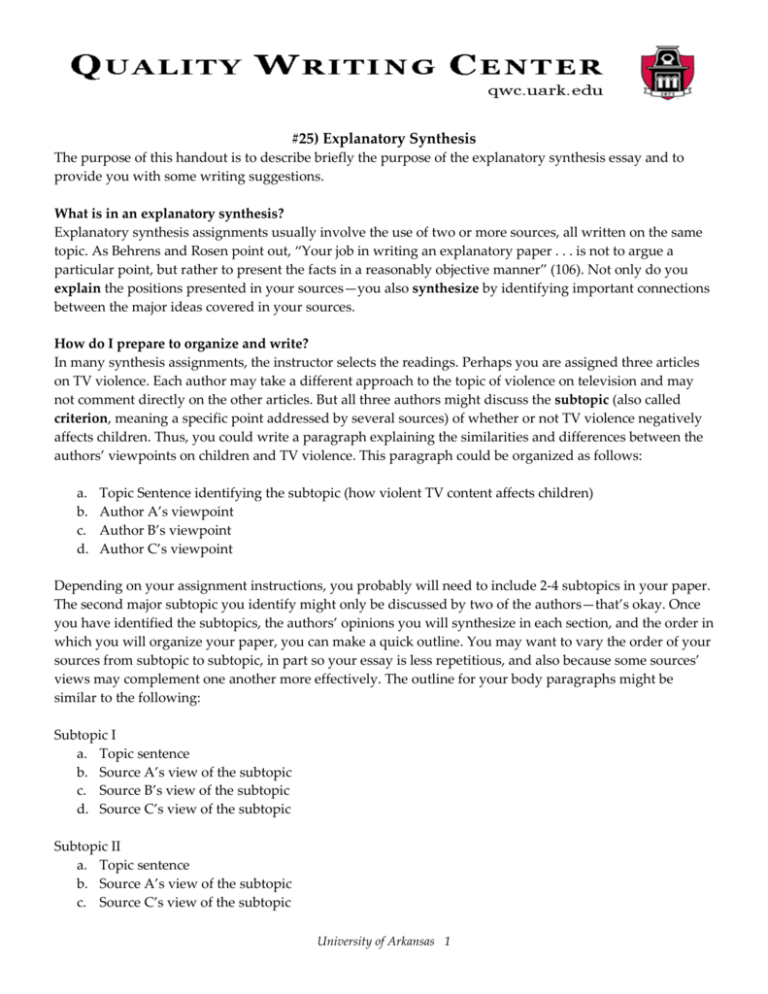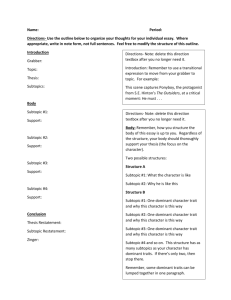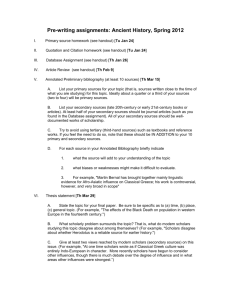
#25) Explanatory Synthesis
The purpose of this handout is to describe briefly the purpose of the explanatory synthesis essay and to
provide you with some writing suggestions.
What is in an explanatory synthesis?
Explanatory synthesis assignments usually involve the use of two or more sources, all written on the same
topic. As Behrens and Rosen point out, “Your job in writing an explanatory paper . . . is not to argue a
particular point, but rather to present the facts in a reasonably objective manner” (106). Not only do you
explain the positions presented in your sources—you also synthesize by identifying important connections
between the major ideas covered in your sources.
How do I prepare to organize and write?
In many synthesis assignments, the instructor selects the readings. Perhaps you are assigned three articles
on TV violence. Each author may take a different approach to the topic of violence on television and may
not comment directly on the other articles. But all three authors might discuss the subtopic (also called
criterion, meaning a specific point addressed by several sources) of whether or not TV violence negatively
affects children. Thus, you could write a paragraph explaining the similarities and differences between the
authors’ viewpoints on children and TV violence. This paragraph could be organized as follows:
a.
b.
c.
d.
Topic Sentence identifying the subtopic (how violent TV content affects children)
Author A’s viewpoint
Author B’s viewpoint
Author C’s viewpoint
Depending on your assignment instructions, you probably will need to include 2-4 subtopics in your paper.
The second major subtopic you identify might only be discussed by two of the authors—that’s okay. Once
you have identified the subtopics, the authors’ opinions you will synthesize in each section, and the order in
which you will organize your paper, you can make a quick outline. You may want to vary the order of your
sources from subtopic to subtopic, in part so your essay is less repetitious, and also because some sources’
views may complement one another more effectively. The outline for your body paragraphs might be
similar to the following:
Subtopic I
a. Topic sentence
b. Source A’s view of the subtopic
c. Source B’s view of the subtopic
d. Source C’s view of the subtopic
Subtopic II
a. Topic sentence
b. Source A’s view of the subtopic
c. Source C’s view of the subtopic
University of Arkansas 1
Subtopic III
a. Topic sentence
b. Source B’s view of the subtopic
c. Source C’s view of the subtopic
However, as Stephen Wilhoit points out, “your job in writing an *explanatory+ synthesis involves more than
summarizing what each critic has to say” (159). When you write the paper, you will synthesize by pointing
out important similarities and differences among the views in your sources.
How do I introduce and conclude my essay?
After you have drafted the body paragraphs, you should draft an introductory paragraph that introduces
the topic, sources, and the debate. Your instructor will ask you to include a thesis statement. In most
argumentative assignments, your thesis statement presents the major claim of your writing. However,
because your purpose in this assignment is an objective presentation of others’ arguments, your thesis
statement should identify the topic under debate and any major similarities or differences in the opinions of
your sources. For example, if you were working with the articles about TV violence, your thesis might read
as follows:
Although the psychologists concede that television violence is on the rise, they disagree about the
seriousness of its potential effects on children, adults, and individuals especially prone to violent
behavior.
To introduce your readers to the particular subtopics you focus on in your essay, your instructor may ask
you to include an essay map. The sample thesis sentence above includes such an essay map. On the other
hand, you may write a thesis statement in one sentence and an essay map in another:
Psychologists concede that television violence is on the rise, but they disagree about the seriousness
of the problem. In particular, experts debate television’s effect on children, adults, and individuals
especially prone to violent behavior.
A conclusion for this essay may simply recap the main points of the discussion and briefly revisit the
authors’ viewpoints. Avoid repeating yourself too much. Depending on your instructor’s guidelines, you
may also want to comment on the importance of the issue.
Be sure to read carefully your instructor’s guidelines for the introduction and conclusion. Assignments vary
by professor, and some may use a comparison-contrast synthesis as a model. However, Behrens and Rosen
state that “comparison and contrast is frequently not an end in itself but serves some larger purpose” (98).
In an explanatory synthesis, you should not just compare and contrast the sources, but explain their
positions fully without taking a side in the debate.
Works Cited
Behrens, Laurence, and Leonard J. Rosen. Writing and Reading across the Curriculum. 4th ed. Boston:
Longman, 2011. Print.
Wilhoit, Stephen. A Brief Guide to Writing from Readings. 4th ed. New York: Pearson Longman, 2007. Print.
University of Arkansas 2






